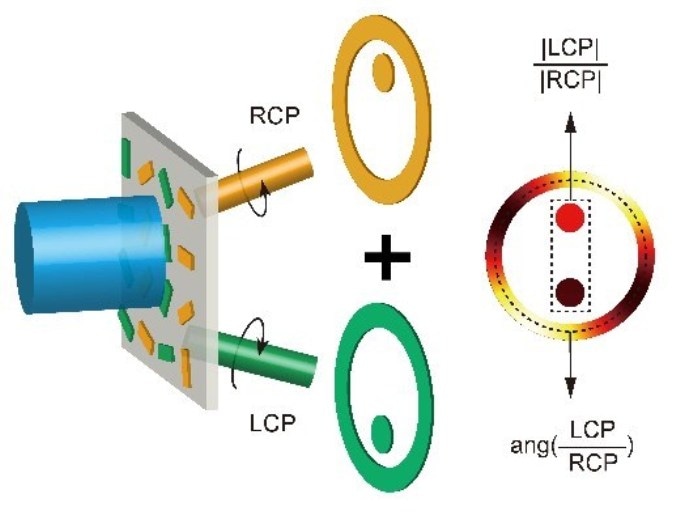Sep 13 2019
Scientists have achieved a new breakthrough by creating holograms with the help of ultra-thin layers of 2D structures called metasurfaces. These holograms can measure light polarization.
 (Image credit: Xueqian Zhang and Jiaguang Han, Tianjin University, and Weili Zhang, Oklahoma State University)
(Image credit: Xueqian Zhang and Jiaguang Han, Tianjin University, and Weili Zhang, Oklahoma State University)
The novel metasurface holograms can be used for creating compact and ultra-fast devices for measuring polarization. Such measurements are used in communications, sensing, and spectroscopy applications.
Metasurfaces can be defined as optical elements that have nanoscale features and a total thickness that is less than 1/50th that of a single strand of human hair. They can be produced using typical microelectronics fabrication methods, allowing large-scale production. In addition, metasurfaces can be easily incorporated into wafer-scale optical systems. But, in spite of these potential features, they are not yet employed in many viable applications.
A multi-institutional team of researchers has reported the study in Optica—The Optical Society’s journal dedicated to high-impact research. The researchers described how metasurface holograms were used effectively and rapidly to measure polarization at near-infrared to visible wavelengths.
The latest study represents a new advancement toward functional metasurface-based devices to support an array of applications ranging from chemical analysis to telecommunications.
Holograms made from metasurfaces are an efficient and effective way to generate high-quality images with subwavelength resolution. Our work uniquely applies metasurface holograms to polarization measurements, which could enable camera-size devices that measure polarization in one step without moving parts.
Xueqian Zhang, Research Team Leader, Tianjin University, China
Measuring Polarization Directly
Sunlight and a majority of the household light sources are known to produce unpolarized light. This light oscillates in all directions. However, optical components like filters can be used for producing polarized light that propagates in only one plane—usually in a horizontal or vertical direction.
Spectrometers and other analytical instruments can measure how the polarization of light changes after it interacts with a material to determine its physical characteristics. It is also possible to use different light polarizations to transmit numerous signals via optical fibers for telecommunications applications.
Traditional techniques used for establishing polarization often need large optical setups, multiple measurements, or accurate adjustment of high-quality optical parts to indirectly establish the polarization state. In the latest study, the investigators employed a metasurface to directly determine polarization. They did this by comparing the phase and amplitude of light waves polarized at right angles to themselves.
Two overlapping holographic images are generated by the metasurface. One image is right-handed circularly polarized (RCP), and the other is left-handed circularly polarized (LCP). An electric field oscillation plane is included in circularly polarized light, and this field rotates to the right or left in a plane vertical to the wave direction.
“The overlapping images can be simply and quickly captured using a CCD camera,” Zhang added. “By analyzing the interference of the two holographic images, we can obtain the amplitude contrast and phase difference between the LCP and RCP components of the incident beam, thus identifying the polarization state.”
Vital to the latest method was an algorithm known as Gerchberg-Saxton, which is extensively employed in holographic studies. The scientists learned how to alter this algorithm so that it can be used for detecting the phase variation between the RCP and LCP components of the incident light in the overlapping holographic images.
Effective Polarization Measurements
The scientists illustrated their novel metasurface holographic technique by applying it to determine the polarization states of illuminating light beams that have known polarizations. Furthermore, the measured polarization states corresponded well with the known equivalents and thus confirmed the effectiveness of the method. In the coming days, the metasurface can possibly be integrated into the photosensitive area of a camera to make a miniaturized device for polarization measurement.
The metasurface used by the scientists is based on the Pancharatnam-Berry phase (also called geometric phase) technique. This technique includes relative phase responses that do not show any dispersion, enabling the metasurface holograms to work across a wide wavelength range.
Our method can be extended to many potential applications requiring polarization measurement, such as polarization spectroscopy, sensing and communications. Polarization-encoded holography could also be used for security information transmission because only a receiver who knows the desired polarization states could decode information from the final holographic images.
Xueqian Zhang, Research Team Leader, Tianjin University, China
Since the researchers have demonstrated the concept, they are now planning to further enhance the efficiency of the technique and will evaluate its performance against traditional commercial instruments used for measuring polarization.